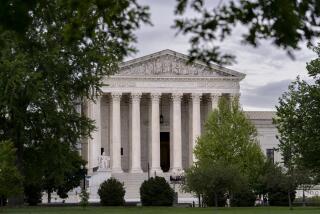High Court Takes a Step Toward Net Porn Rules
- Share via
WASHINGTON — The Supreme Court breathed new life Monday into a law designed to shield children from pornography on the Internet, ruling that the “most puritan” community may decide what is harmful to minors, even if a Web site based elsewhere is prosecuted based on this strict standard.
On an 8-1 vote, the court reversed a lower court’s ruling that had struck down the Child Online Protection Act because it relied on “community standards” for deciding what is “patently offensive” for minors under age 17.
But the cautious and complex ruling stops well short of upholding the 1998 law, which has never been enforced and will not be, at least for now. The court sent the case back to the lower court to address other free-speech challenges, which could take years.
The case illustrates the difficulty that the federal government has encountered in trying to corral portions of the unruly Internet without trampling the 1st Amendment.
“The scope of our decision today is quite narrow,” Justice Clarence Thomas wrote. “We hold only that [the Child Online Protection Act’s] reliance on community standards to identify ‘material that is harmful to minors’ does not by itself render the statute” unconstitutional under the 1st Amendment.
Magazine and book publishers must live with this “community standards” rule, Thomas said, and the 1st Amendment does not create a special exemption for commercial Web sites.
“If a publisher chooses to send its material into a particular community,” he wrote, “it is the publisher’s responsibility to abide by that community’s standards.”
But the justices, while concurring in a lopsided vote, were unusually divided in their opinions. Paradoxically, several in the majority did not appear to support the notion of allowing local standards to govern the Internet.
In the end, the court neither upheld the law nor allowed it to be enforced. Instead, they sent the matter back to the lower court in Philadelphia to consider other free-speech challenges to the law.
Nonetheless, Monday’s decision takes a step, albeit a tentative one, toward allowing the first federal restrictions on what can be transmitted via the Internet.
In its short history, the Internet has been championed as a truly free flow of communication and information. But with that freedom has come a large volume of hard-core pornography, much of which can be accessed by children and teenagers. In 1998, there were about 28,000 adult sites promoting pornography on the Web.
Shielding Children From Online Porn
Congress has been determined to block children from clicking onto sexually explicit Web sites.
In 1996, the Communications Decency Act made it a federal crime to send sexually explicit messages or communications to anyone under age 18.
A year later, however, a unanimous Supreme Court struck down that law, saying it was too broad and vague. It raised the specter that someone could be prosecuted for sending an e-mail or posting a provocative photo that was subsequently brought up on a minor’s computer screen thousands of miles away.
Undaunted, Congress in 1998 adopted a narrower, more specific ban on computer transmissions that are “harmful to minors.”
The Child Online Protection Act applied only to material posted on the Web “for commercial purposes.” This excluded e-mails as well as Web sites that are entirely free. It is not clear, though, whether the law meant to include sites that are free to users but make money from advertisements.
The new law lowered the age of protected minors to those under 17.
It also adopted a new, three-part definition of what is banned. It covered “sexual acts” and “lewd exhibitions” that the “average person, applying contemporary community standards, would find, taking the material as a whole and with respect to minors, is designed ... to pander to the prurient interest and ... lacks serious literary, artistic, political or scientific value for minors.”
The law also sought to shield Web sites that screened out minors by, for example, requiring them to supply a credit card number.
Nonetheless, before it could go into effect, the American Civil Liberties Union went back to court in Philadelphia to challenge it as unconstitutional.
The ACLU’s clients included Salon magazine, which feared it could be prosecuted because of its sexual advice column, and the owners of a gay and lesbian bookstore, which posted material on its Web site. While neither site sought to appeal to minors, their sponsors say they could not easily prevent them from tapping into the sites.
When freedom of speech is at issue, the Supreme Court has been willing to block new laws based on how they might be used, even when no one has been prosecuted.
Last month, the justices struck down a portion of the Child Pornography Prevention Act of 1996 that made it a crime to own or sell “computer generated” children engaged in sexual acts, saying it could apply to animated figures or purely imaginary scenes.
Similarly, the ACLU said the Child Online Protection Act should be struck down before it goes into effect because it could chill communication on the Internet.
Its lawyers argued the 1998 law had the same flaw as the 1996 version. Since Web sites cannot know who will access their material, they are held responsible if minors click on to it, they said.
‘Most Puritan’ Community Is Cited
A federal judge in Philadelphia agreed and blocked the law from taking effect. The U.S. appeals court there ruled the law unconstitutional because it would allow the “most puritan” community in the nation to regulate the Internet.
For example, prosecutors could bring charges in Provo, Utah, against a San Francisco-based Web site, the appeals court judges said.
The Justice Department appealed in the case of Ashcroft vs. ACLU, 00-1293, and won a reversal.
Those who fear prosecution for distributing pornography “need only take the simple step of utilizing a [different] medium that enables it to target the release of its material,” Thomas wrote.
Despite the near-unanimous vote and Thomas’ strong words, most of the justices did not appear to agree on what was said. Only Chief Justice William H. Rehnquist and Justice Antonin Scalia joined Thomas’ opinion in full.
Justice Sandra Day O’Connor signed it but said she believed there must be a national standard for what is harmful to minors. Justice Stephen G. Breyer wrote a separate opinion making the same point.
Three others--Justices Anthony M. Kennedy, David H. Souter and Ruth Bader Ginsburg--voted with the majority but joined a separate opinion casting doubt on the constitutionality of the law.
Justice John Paul Stevens dissented and said the law should be struck down.
“It is quite wrong to allow the standards of a minority consisting of the least tolerant communities to regulate access to relatively harmless messages in this burgeoning market,” he said.
Both Sides in Debate Claim a Victory
Reflecting the split outcome, both sides said they were pleased.
Barbara Comstock, a Justice Department spokeswoman, said officials there were “pleased the Supreme Court has vacated the decision” of the lower court. It takes a step toward “keeping our nation’s children safe from viewing the pornography for sale on the Internet.”
Meanwhile, the ACLU’s lawyer, Ann Beeson, said she was pleased the court did not allow the law to go into effect.
“The court clearly had enough doubts about this broad censorship law to leave in place the ban, which is an enormous relief to our clients,” she said.
When the case goes back to Philadelphia, the ACLU lawyers will renew the main argument that the effort to restrict content on the Internet is hopelessly flawed.
Since sponsors of Web sites do not know who is downloading their material, they should not be punished if a minor accesses it, they say.
Further, if this restriction becomes law, it will force Web sites to post only material that is suitable for minors, and the 1st Amendment does not allow the government to impose such a restriction on American adults, they argue.



